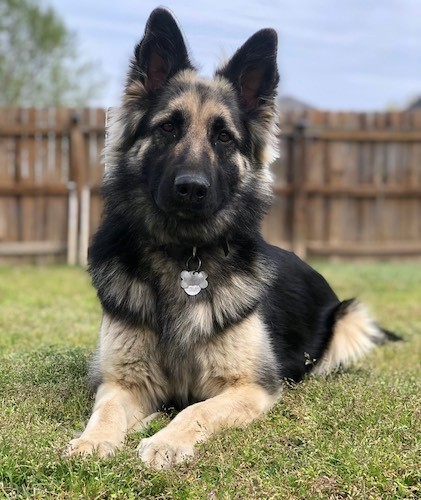
A purebred German Shepherd Dog.
Ger-man shep-herd
The German Shepherd Dog is well proportioned and very strong. The GSD has a sturdy, muscular, slightly elongated body with a light, solid bone structure. The head should be in proportion to its body, and the forehead a little rounded. The nose is most often black, however, blue or liver still do sometimes occur, but are considered a fault and cannot be shown. The teeth meet in a strong scissors bite. The dark eyes are almond-shaped, and never protruding. The ears are wide at the base, pointed, upright and turned forward. The ears of puppies under six months may droop slightly. The bushy tail reaches below the hocks and hangs down when the dog is at rest. The front legs and shoulders are muscular and the thighs are thick and sturdy. The round feet have very hard soles. There are three varieties of the German Shepherd: double coat, plush coat and longhaired coat. The coat most often comes in black with tan, sable or all black, but also can come in white, blue and liver, but those colors are considered a fault according to most standards. The white GSD dogs are recognized as a separate breed by some clubs and are being called the American White Shepherd. A piebald color has also occurred in a single GSD bloodline that is now being called a Panda Shepherd. A Panda is 35% white the remainder of color is black and tan, and has no white German Shepherds in its ancestry.
Often used as working dogs, German Shepherds are courageous, keen, alert and fearless. Cheerful, obedient and eager to learn. Tranquil, confident, serious and clever. GSDs are extremely faithful, and brave. They will not think twice about giving their lives for their human pack. They have a high learning ability. German Shepherds love to be close to their families, but can be wary of strangers. This breed needs his people and should not be left isolated for long periods of time. They only bark when they feel it is necessary. Often used as police dogs, the German Shepherd has a very strong protective instinct, and is extremely loyal to its handler. Socialize this breed well starting at puppyhood. Aggression and attacks on people are due to poor handling and training. Problems arise when an owner allows the dog to believe he is pack leader over humans and/or does not give the dog the mental and physical daily exercise it needs to be stable. This breed needs owners who are naturally authoritative over the dog in a calm, but firm, confident and consistent way. A stable, well-adjusted, and trained dog is for the most part generally good with other pets and excellent with children in the family. They must be firmly trained in obedience from an early age. German Shepherds with passive owners and/or whose instincts are not being met can become timid, skittish and may be prone to fear biting and develop a guarding issue. They should be trained and socialized from an early age. German Shepherds will not listen if they sense that they are stronger minded than their owner, however they will also not respond well to harsh discipline. Owners need to have an air of natural authority to their demeanor. Do not treat this dog as if he were human. Learn canine instincts and treat the dog accordingly. German Shepherds are one of the smartest and most trainable breeds. With this highly skilled working dog comes a drive to have a job and a task in life and a consistent pack leader to show them guidance. They need somewhere to channel their mental and physical energy. This is not a breed that will be happy simply lying around your living room or locked out in the backyard. The breed is so intelligent and learns so readily that it has been used as a sheepdog, guard dog, in police work, as a guide for the blind, in search and rescue service, and in the military. The German Shepherd also excels in many other dog activities including Schutzhund, tracking, obedience, agility, flyball and ring sport. His fine nose can sniff out drugs and intruders, and can alert handlers to the presence of underground mines in time to avoid detonation, or gas leaks in a pipe buried 15 feet underground. The German Shepherd is also a popular show and family companion.
Height: Males 24 - 26 inches (60 - 65 cm) Females 22 - 24 inches (55 - 60 cm)
Weight: 77 - 85 pounds (35 - 40 kg)
Indiscriminate breeding has led to hereditary diseases such as hip and elbow dysplasia, blood disorders, digestive problems, bloat, epilepsy, chronic eczema, keratitis (inflammation of the cornea), dwarfism and flea allergies. Also prone to splenic tumors (tumors on the spleen), DM (degenerative myelitis), EPI (exocrine pancreatic insufficiency), and perianal fistulas and Von Willebrand's disease.
The German Shepherd will do okay in an apartment if sufficiently exercised. They are relatively inactive indoors and do best with at least a large yard.
German Shepherd Dogs love strenuous activity, preferably combined with training of some kind, for these dogs are very intelligent and crave a good challenge. They need to be taken on a daily, brisk, long walk, jog or run alongside you when you bicycle. While out on the walk the dog must be made to heel beside or behind the person holding the lead, as in a dog's mind the leader leads the way, and that leader needs to be the human. Most shepherds love to play ball or Frisbee. Ten to fifteen minutes of fetching along with daily pack walks will tire your dog out quite nicely as well as give him a sense of purpose. Whether it is ball chasing, Frisbee catching, obedience training, participation in a canine playgroup or just taking long walks/jogs, you must be willing to provide some form of daily, constructive exercise. The daily exercise must always include daily walks/jogs to satisfy the dog’s migration instinct. If under-exercised and/or mentally challenged, this breed can become restless and destructive. Does best with a job to do.
Around 13 years.
About 6 to 10 puppies
This breed sheds bits of hair constantly and is a seasonally heavy shedder. They should be brushed daily or you will have hair all over your home. Bathe only when necessary; over bathing can cause skin irritation from oil depletion. Check ears and trim claws regularly.
In Karlsruhe, Germany, Captian Max von Stephanitz and other dedicated breeders produced a responsive, obedient and handsome German Shepherd using longhaired, shorthaired and wire-haired local herding and farm dogs from Wurtemberg, Thurginia and Bavaria. The dogs were presented at Hanover in 1882, and the shorthaired variety was first presented in Berlin in 1889. In April 1899, von Stephanitz registered a dog named Horan as the first Deutsche Schäferhunde, which means “German Shepherd Dog” in English. Until 1915, both longhaired and wire-haired varieties were shown. Today, in most countries, only the short coat is recognized for show purposes. The first GSD was shown in America in 1907 and the breed was recognized by the AKC in 1908. The German Shepherd Dogs used in movies Rin-Tin-Tin and Strongheart brought a lot of attention to the breed, making it very popular.
Herding, AKC Herding
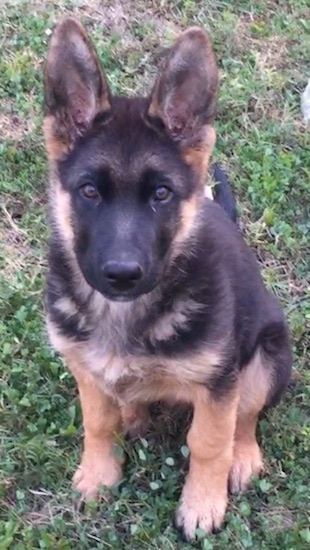
Max the German Shepherd as a puppy at 3 months old from Pakistan—"I got him from my friend when he was only one week old"

Titan the German Shepherd puppy at 6 months old.
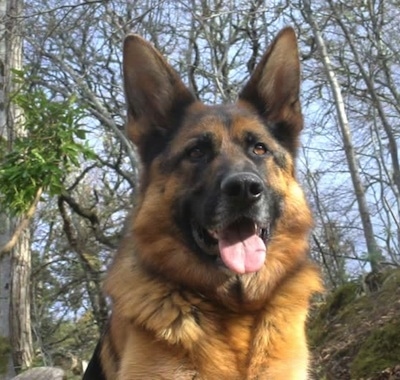
"This is Lewis, our five-year-old German Shepherd Dog. He is the most faithful and loving dog you could ever wish for. He loves long walks in the hills where we live in Scotland, but when at home is totally undemanding. If in the house he will watch with interest any task being undertaken, if out in the garden he quite happily watches us build our house—while occasionally being distracted by the resident martins and swallows, or bees!! When young, he had nervous aggression problems and we were advised to have him destroyed. Obviously we had no intention of that happening and we persevered with his training. He can now be handled without problem when at the vet, but is also a good guard dog around our garden and home. We are very proud of him for both the progress he has made with his temperament and because he is such a handsome boy. We used various training techniques, but feel we gained such invaluable advice into dog behaviour from Cesar Millan. A big thank you from us both, we have a gorgeous dog and love him to bits."
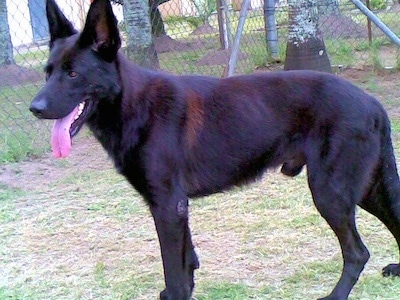
"This is Blixem, my black 5-year-old, 35-kg (77 pounds) German Shepherd from RSA KZN, a working police dog. He is trained in obedience and aggression used in the tracking of fleeing suspects on foot. He has been awarded the best dog during his training in terms of obedience, aggression and tracking. He is sociable and loves to be pampered. His motivation is my personal attention and time dedicated to him which has contributed to the close bond we have. His understanding in our communication is amazing."
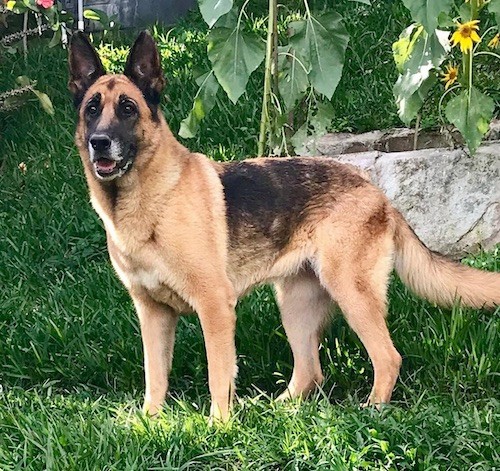
Akela the German Shepherd at 9 years old
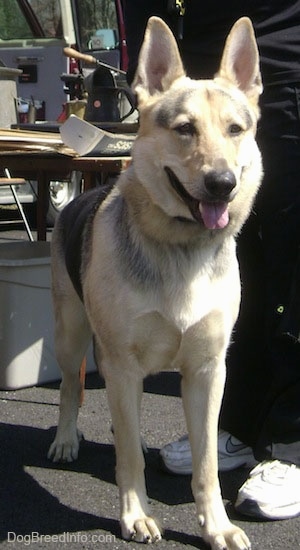
Adult working rescue German Shepherd Dog at 1 year old
Photo courtesy of Vom Haus Drage Kennel & Pet Resort
Lupo the longhaired German Shepherd at 9 months—see Lupo growing-up

Prudy the German Shepherd is about 5 years old in this picture and, as always, chasing a tennis ball.
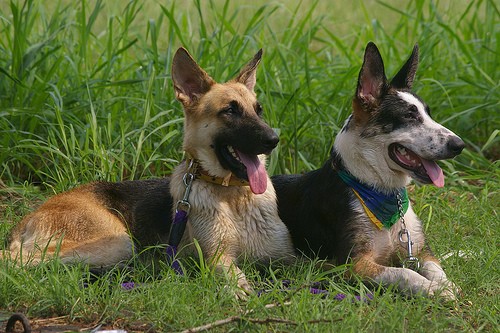
Riza (left) at 1 year and 6 months old and Hitman (right) at 6 months old—Hitman is what is called a Panda Shepherd. It is a color mutation in the purebred German Shepherd Dog occurring in a single bloodline.